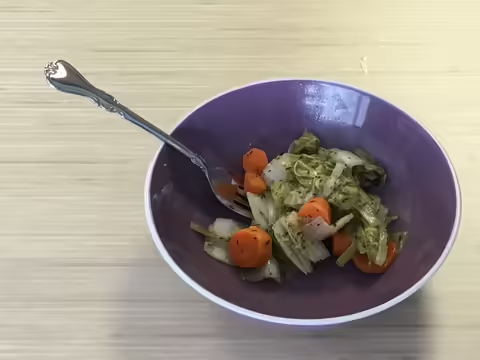
Leeks aren't an ingredient I use much at all myself, probably because I don't see them in my rural grocery store. When I shop bigger stores or farmers markets where leeks might be available, I'll keep an eye out. Particularly in autumn because leeks pair so well with many fall-inspired recipes.
Leeks are a member of the allium family. Instead of forming a large, round bulb like an onion, leeks develop a long stem with thick green leaves and a tender, edible stalk.
Nutritionally, 1 cup of leek contains around 55 calories, 13g carbohydrate, 2g fiber, and is a source of vitamins and minerals, including vitamins A and K, folate, and potassium. Like other vegetables, leeks are not a significant source of fat, protein, or sodium.
- Buy: Choose fresh leeks with a firm stalk - the white and light green part. Look for leek leaves that are deep green in color, and avoid those with yellowing or limp leaves.
- Price: Leek prices will vary by season and region. Check with local farmers in your area who might grow and sell them.
- Store: Keep unwashed leeks refrigerated and use within a few weeks.
- Prepare: Cut away the dark green leaves and save for vegetable broths or stocks. Use the white and light green portions for recipes. Be sure to rinse leeks well, since they pick up soil between their many layers as they grow.
- Preserve: South Dakota's Extension notes that leeks can be dried. Canning and freezing are not recommended.
- Eat: While often used in cooked recipes, leeks can be eaten raw too. The braised recipe below was inspired from a Community Supported Agriculture recipe program in my area from several years ago.
- Eat around the Country: Also, check out these tasty recipes from other state Extension: Sautéed Leeks and Apples, Creamy Potato Leek Soup, Leek and Mushroom Orzo, Apple and Leek Pork Chops, and Leek and Potato Frittata. So many autumn vibes!
Braised Napa Cabbage with Carrots and Leek | Print recipe | Watch video
serves 6
Half a head of Napa cabbage, core removed and cut into thin strips
4 carrots, peeled and cut into coins
1 large leek
1 cup fat-free, reduced-sodium chicken broth
1 Tbsp oil
1 Tbsp dried thyme leaves
1/2 tsp black pepper
1/4 tsp paprika
- Wash hands with soap and water.
- Rinse cabbage and carrots under cool water. Cut vegetables as described in Ingredients list. Set aside.
- Rinse leek under cool water. Cut off dark green leaves and end of stem, keeping the white and light green parts of the leek. Trim leek into thin rings and rinse under cool water to remove any soil trapped between leek’s layers.
- In a large skillet over medium heat, add cabbage, carrots, leek, chicken broth, and oil. Cook uncovered for 10 minutes, stirring occasionally.
- Add thyme, paprika, and pepper, and stir to combine. Continue cooking another 10 minutes until most of broth is evaporated and vegetables are tender.
Nutritional analysis per serving: 60 calories, 2.5g fat, 170mg sodium, 8g carbohydrate, 2g fiber, 2g protein
Resources
- USDA, FoodData Central
- Penn State Extension. Pennsylvania Produce: A Guide to Produce Grown in Pennsylvania, 2016, Leek, pg 29
- Oregon State University Extension Service, Food Hero, Leek Basics, 2017
- South Dakota University Extension, Pick it! Try it! Like it! Leeks, 2019
Post originally published in 2015; content updated in 2021.
Healthy Eats and Repeat
How much difference is there between canned and frozen foods? How should you cook venison? When is the best time to buy avocados? Get answers to these questions as well as other tips, tutorials and recipes for common kitchen foods and items with University of Illinois Extension Nutrition & Wellness Educator Caitlin Mellendorf’s blog Healthy Eats and Repeat. Build your best life. Trust Extension to help.
Caitlin Mellendorf is an Illinois Extension Nutrition and Wellness Educator serving DeWitt, Macon and Piatt Counties in Central Illinois. She is a Registered Dietitian and her work focuses on helping community members gain the knowledge, skills and tools to live healthier, more nutritious lifestyles. This includes providing programs and answering questions about heart health, diabetes, food safety, food preservation, grocery shopping and cooking. You can reach Caitlin by email at chuth2@illinois.edu or call 217.877.6042. Check out her nutrition blog Healthy Eats and Repeats for seasonal recipes and of an exploration of common kitchen foods.
